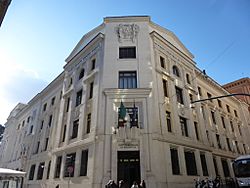Italian National Institute of Statistics facts for kids
 Istat headquarters in Rome |
|
| Institute overview | |
|---|---|
| Formed | 1926 |
| Jurisdiction | Italian Government |
| Headquarters | Rome, Italy |
| Institute executive |
|
The Italian National Institute of Statistics (called Istat) is the main place in Italy that collects and shares official facts and figures. Think of it like a big data detective agency for the whole country! Istat does many important things, such as counting the population (a census), checking on businesses, and studying social, economic, and environmental topics. It's the biggest producer of statistics in Italy and works closely with the European Statistical System, which is managed by Eurostat.
Contents
How Istat Started
Istat was created on July 9, 1926. It was first called the Central Institute of Statistics. Its job was to take over from the old General Statistics Division of the Ministry of Agriculture. Corrado Gini was the first person in charge of the institute.
At the start, Istat had about 170 workers. Their first big task was to publish the information from the 6th general population census. This census updated numbers from earlier counts.
Challenges and Changes
In the early 1930s, Istat was very busy. However, Italy faced economic problems because of the Second Italo-Ethiopian War. This made it hard for Istat to publish economic or financial data. Information that had been collected was finally published in 1937, but this stopped again two years later.
When Second World War started, Istat published even less. Many staff members had to join the military. This caused the 9th population census to be delayed until 1951. During the war, Istat's main office had to move because of the Armistice of Cassibile in 1943.
After the war, Istat's old records were brought back to Rome. This allowed the institute to start working fully again. As Italy rebuilt, Istat focused on gathering new information about the country's growth. This led to a special book called "Studies on National Revenue" in 1950.
In 1989, a new law changed the institute's name to the National Institute of Statistics. However, its short name, Istat, stayed the same. Istat's publications are available for everyone to use and share, as long as they say where the information came from.
How Istat Works
Istat is organized in a special way to make sure it runs smoothly. Here are the main parts:
- President: This person is like the boss of Istat. They are chosen by the President of Italy and the Prime Minister. The President leads the institute and makes sure its scientific and technical work is done well. They serve for four years and can be chosen again only once.
- Policy-making and Statistics Information Coordination Committee: This group helps guide Istat's work. It has 15 members, including the President, and they also serve for four years.
- Governing Board: This board directs and watches over everything Istat does. It includes the President and nine other members.
- Board of Auditors: This board checks Istat's money records. They make sure that the financial reports match the actual spending. This board has members from different parts of the Italian government.
Istat's Leaders (Presidents)
Here are the people who have led Istat over the years:
Central Institute of Statistics (until 1989):
- Alberto Canaletti Gaudenti (1945 - 1949)
- Lanfranco Maroi (1949 - 1961)
- Giuseppe De Meo (1961 - 1980)
- Guido Maria Rey (1980 - 1989)
National Institute of Statistics (since 1989):
- Guido Maria Rey (1989 - 1993)
- Alberto Zuliani (1993 - 2001)
- Luigi Biggeri (2001 - 2009)
- Enrico Giovannini (2009 - 2013)
- Antonio Golini (2013 - 2014)
- Giorgio Alleva (2014 - 2018)
- Gian Carlo Blangiardo (2019 - Present)
How to Get Istat Information
Istat makes its information available to everyone in several ways:
Information Offices
Istat has 18 offices around Italy. These are called Statistical Information Centers. People can visit these centers to get facts and figures. The office in Rome also has data from Eurostat, which is the statistics office for the whole European Union.
Library
Istat has a library that opened in 1926. It's open to the public! The library has many Istat publications and books about statistics and how societies and economies work. It also has journals from other countries' statistics offices and international groups like the United Nations. The library has about 400,000 books and gets around 2,800 different magazines and journals regularly. There are even 1,500 very old books from before 1900!
Online Databases
Istat also provides online tools where you can look at and download data for free. You can find lots of information on their websites like dati.istat.it and seriestoriche.istat.it.
See also
 In Spanish: Istituto Nazionale di Statistica para niños
In Spanish: Istituto Nazionale di Statistica para niños

